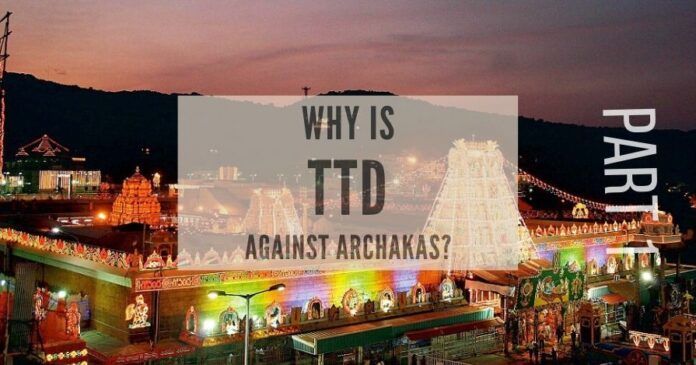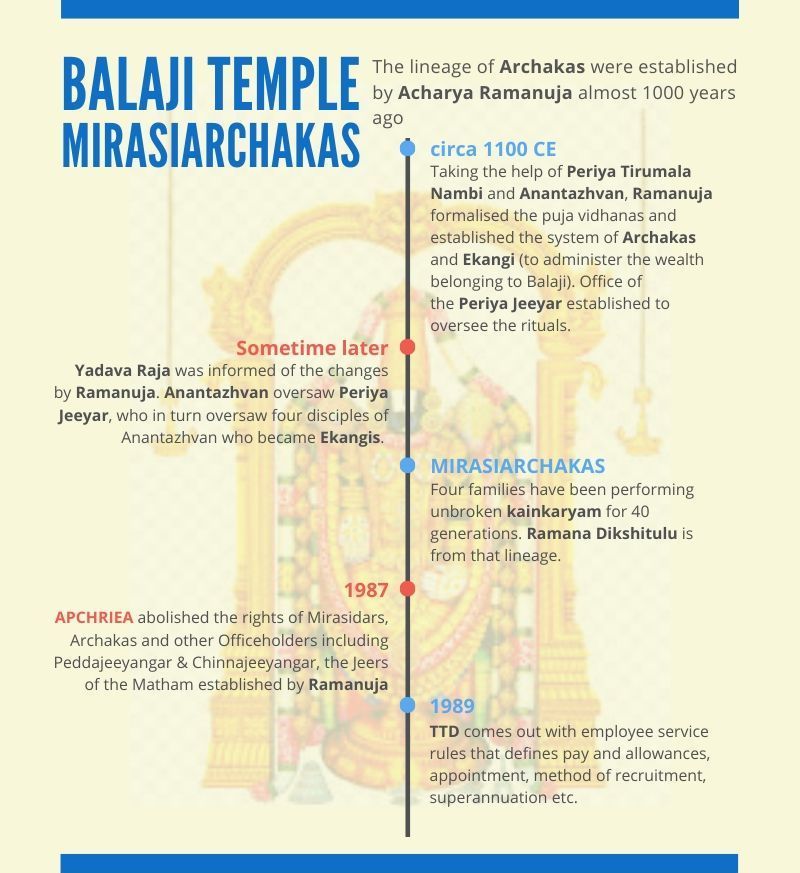
The Protectors of Rituals and Customs
To learn briefly on the MirasiArchakas, here is a recap of my two-part article on Tirumala Issue – Major allegations and the way forward:
Part-1
https://www.pgurus.com/tirumala-issue-major-allegations-and-the-way-forward/
Part-2
https://www.pgurus.com/tirumala-issues-part-2-the-way-forward/
The MirasiArchakas
For around 40 generations, four families of hereditary MirasiArchakas were rendering Kainkaryam (eternal service at the sacred feet of the Lord) to Bhagawan Venkateshwara and four families of hereditary MirasiArchakas to Goddess Padmavathi Ammavaru, Tiruchanur. While Tirumala Mandir follows the VaikhanasaAgamam, Tiruchanur Mandir follows the PancharatraAgamam. The MirasiArchakas at both Mandirs had the Dharmic responsibility of conducting various Pujas, safe-guarding the rituals as per the respective Agamas, and responsibility coupled with accountability of the Bhagawan’s and Ammavari jewels. Here is just one example of what happened to Bhagawan’s jewels when the responsibility was taken away from the MirasiArchakas and usurped by an irresponsible and the non-accountable Andhra Pradesh (AP) Government through its proxy, the Tirumala Tirupati Devasthanam (TTD) Board: A Case of Missing Jewellery of Bhagawan Balaji[1].
While the Mandir administration was vested with the TTD, the religious functions were always the domain of the MirasiArchakas. Successive governments continued to find this inconvenient to fulfilling their nefarious greed. They weren’t satisfied with the complete control of the administration, its endowments, and finances. The religious activities were not under their direct control. They sat down to design a long-term devious plan to dismantle the hereditary Mirasi Archakatvam. This is similar to how Christianity makes long-term specific plans to destroy cultures and thus, civilizations. In TTD, sadly it is the Dhimmi Hindus who make the proposals, the Board resolutions, the proceedings, and the long-term plans for their Political masters, the Adharmic Hindus, Crypto-Christians and Christians. These political masters and their proxies in the Board want only Board-compliant Archakas. Not someone who would stand up for sastras, customs, and practices or who will question their adharmic decisions. This irked the Board and their masters in the Government of the day. Successive Executive Officers (EO) and Joint Executive Officers (JEO) and the politically appointed Board were always tasked to devise ways to do away with these four families. The plan was to do away with the hereditary Archakatvam, and to gain control of the GarbhaGruham, the sanctum sanctorum. And over a period of time to gradually and imperceptibly commence the dilution of the Nithya Pujas, Naivedyam, Utsavams, and the Agama Vidhanas. If this is allowed to happen in the Tirumala Mandir, it would be easy to replicate the template in any Mandir. Thus, achieve the anti-dharmic objective of wanton neglect of our ancestral wisdom, our Sastras, culture and dilution of all that Bhagawad Ramanuja[2] and the Vaikanasa Agama ordained for the Mandir.
The Gamekars
As further background to the reader, once upon a time, all religious responsibilities of Pujas, Utsavams, the responsibility of safe-keeping of the jewels etc., were under the hereditary ArchakaMirasi, while all prasadams including Laddu, etc., were under the hereditary Gamekars. Potu is the Srivari Kitchen. The MirasiArchakas were hereditary while their assistants called the ArchakaGumastas were engaged by them and are NON-hereditary. A section of the Potu employees making Srivari Prasadams were employees of the TTD, while a large section of them involved in making Laddus were under the contract of the erstwhile Gamekars.
What this series is about
In this series, I shall deal with how the TTD and the different governments of AP resorted to illegality in retiring the MirasiArchakas and stripping them of their right to Kainkaryam to Bhagawan – a very important and central step to taking control of the Sanctum Santorum, and to eventually pave the way to systematic dilution of the tradition and customs of the Mandir. I shall extensively resort to quoting from the HC judgment and the orders of the Supreme Court, both appended with the appropriate part of the series, along with my notes.

Position of Hereditary archakas during 1987-97
- The A.P. Charitable and Hindu Religious Institutions and Endowments Act, 1987 (Act 30 of 1987) abolished hereditary rights of Mirasidars, Archakas and other Officeholders and servants in Section 34 of the Act. (Note: This not only includes the MirasiArchakas, but also the Peddajeeyangar and Chinnajeeyangar, meaning the TTD and the government can retire or appoint the Jeeyars of the Matham established by Bhagawad Ramanuja).
- The A.P. Charitable and Hindu Religious Institutions and Endowments Archakas and other Office Holders and Servants Qualifications and Emoluments Rules, 1987 were framed by the State Government vide G.O.Ms.No.1171, Revenue (Endts.I) dt.16-12-1987. (G.O.1171 attached).
- Part-I dealt with Archakas and other Office Holders and Servants of Charitable Religious Institutions other than the TTD. Part-II dealt with those employed in TTD mentioned in Schedule-III and IV. Para-8 of Part-II stated that every person holding the post mentioned in the Schedule-III shall retire on attaining the age of 65 Schedule-III mentioned 28 posts such as Archakam Supervisor, Archaka Grade-I, Archaka Grade-II, Archaka Grade-III etc. (Note: This G.O. doesn’t specifically mention MirasiArchakas or hereditary Archakas, so where does retiring them at 65 come in for the erstwhile MirasiArchakas using this G.O?)
Service Rules framed in 1989
Later, the TTD Employees Service Rules, 1989 were also framed vide G.O.Ms.No.1060, revenue (Endowments-I) Department dt.24.10.1989. These rules provided for pay and allowances, appointment, method of recruitment, fixation of the strength of establishment, and superannuation of employees of TTD (Rule 12).It states:
Superannuation – The age of superannuation of every employee of Tirumala Tirupathi Devasthanams shall be regulated by the provisions of the Andhra Pradesh Public Employment (Regulations of Superannuation) Act, 1984 (Act 23 of 1984) amended from time to time.”(Note: These are service rules for Employees including the Archakas employed by the TTD. There is NO MENTION of Hereditary Archakas or the MirasiArchakas, who ARE NOT EMPLOYEES OF TTD. We shall come later on to what the SC, HC of AP and a crucial Board resolution of TTD says on the relationship between the MirasiArchakas and the TTD).
Both the G. O.s are published below.
To be continued…
References:
[1] A case of missing jewelry of Bhagawan Balaji – Aug 30, 2019, PGurus.com
[2] Some practices that Ramanuja instituted in Tirumalai temple – Apr 21, 2016, Medium.com
Note:
1. The views expressed here are those of the author and do not necessarily represent or reflect the views of PGurus.
- Can we do it, please? - August 21, 2023
- Coaching Beyond – My days with Indian Cricket Team - June 28, 2023
- Who Killed SSR? – A book review (SSR-Sandeep Singh Rajput) - April 5, 2023











[…] 1 of this series can be accessed here. This is Part […]